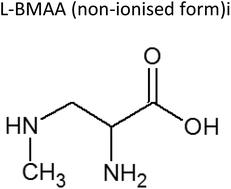当前位置:
X-MOL 学术
›
Toxicol. Res.
›
论文详情
Our official English website, www.x-mol.net, welcomes your feedback! (Note: you will need to create a separate account there.)
Environmental distribution of the neurotoxin l-BMAA in Paenibacillus species.
Toxicology Research ( IF 2.1 ) Pub Date : 2019-10-03 , DOI: 10.1039/c9tx00203k Peter B Nunn 1 , Geoffrey A Codd 2, 3
Toxicology Research ( IF 2.1 ) Pub Date : 2019-10-03 , DOI: 10.1039/c9tx00203k Peter B Nunn 1 , Geoffrey A Codd 2, 3
Affiliation

|
The environmental distribution of the neurotoxic amino acid, 3-N-methyl-2,3-diaminopropanoic acid (BMAA), first isolated in 1967, was initially believed to be limited to tropical and subtropical plants of the genus Cycas. The seeds of one such species, which had been used historically on the Pacific island of Guam as a foodstuff, had a reputation for neurotoxicity. Some 40 years later the amino acid was detected in terrestrial and aquatic cyanobacteria and in other aquatic organisms. Overlooked was the discovery of BMAA in peptides of bizarre structure that had been isolated in 1975 from Paenibacillus pulvifaciens during a search for antibiotics. More recently (2014), peptides of similar structure were isolated from Paenibacillus larvae; this organism is causative of American Foulbrood, a lethal disease of honeybee colonies. These are interesting chemical and environmental observations, but knowledge of the bacterial distribution of BMAA is limited to just these two species of Paenibacillus, while more than 200 Paenibacillus spp. are known. Paenibacillus spp. are ever present naturally in the environment and are used agriculturally; recent research reports that some species infect human foods – including cow's milk – and have been isolated from human body fluids. We wish to stimulate interest in the environmental distribution of the neurotoxic BMAA in Paenibacillus spp. by drawing together previously isolated streams of research and by proposing experimental approaches by which this matter might be resolved.
中文翻译:

在Paenibacillus物种中神经毒素1-BMAA的环境分布。
神经毒性氨基酸3 - N-甲基-2,3-二氨基丙酸(BMAA)的环境分布最初被发现于1967年,最初被认为仅限于苏铁属的热带和亚热带植物。一种这样的物种的种子,历史上曾在太平洋关岛上用作食品,在神经毒性方面享有盛誉。大约40年后,在陆生和水生蓝细菌以及其他水生生物中检测到了该氨基酸。1975年在寻找抗生素的过程中从古生芽孢杆菌分离出的奇怪结构的肽中发现了BMAA,这一发现却被忽略了。最近(2014年),从Paenibacillus幼虫中分离了具有相似结构的肽; 这种微生物是蜜蜂群体致死性疾病美国富勒德氏菌的病因。这些是有趣的化学和环境观察,但是对BMAA细菌分布的了解仅限于这两种Paenibacillus,而200多个Paenibacillus spp。众所周知。芽孢杆菌属 曾经自然存在于环境中并用于农业;最近的研究报告指出,某些物种会感染人类食品,包括牛奶,并且已经从人体液体中分离出来。我们希望激发人们对Paenibacillus中毒BMAA的环境分布的兴趣spp。通过汇集以前孤立的研究流,并提出可以解决此问题的实验方法。
更新日期:2019-10-03
中文翻译:

在Paenibacillus物种中神经毒素1-BMAA的环境分布。
神经毒性氨基酸3 - N-甲基-2,3-二氨基丙酸(BMAA)的环境分布最初被发现于1967年,最初被认为仅限于苏铁属的热带和亚热带植物。一种这样的物种的种子,历史上曾在太平洋关岛上用作食品,在神经毒性方面享有盛誉。大约40年后,在陆生和水生蓝细菌以及其他水生生物中检测到了该氨基酸。1975年在寻找抗生素的过程中从古生芽孢杆菌分离出的奇怪结构的肽中发现了BMAA,这一发现却被忽略了。最近(2014年),从Paenibacillus幼虫中分离了具有相似结构的肽; 这种微生物是蜜蜂群体致死性疾病美国富勒德氏菌的病因。这些是有趣的化学和环境观察,但是对BMAA细菌分布的了解仅限于这两种Paenibacillus,而200多个Paenibacillus spp。众所周知。芽孢杆菌属 曾经自然存在于环境中并用于农业;最近的研究报告指出,某些物种会感染人类食品,包括牛奶,并且已经从人体液体中分离出来。我们希望激发人们对Paenibacillus中毒BMAA的环境分布的兴趣spp。通过汇集以前孤立的研究流,并提出可以解决此问题的实验方法。



























 京公网安备 11010802027423号
京公网安备 11010802027423号